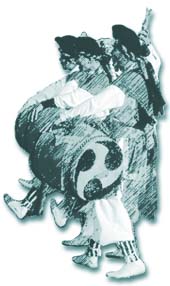
 |
|
| An Introduction to the mysteries of Okinawan Music and its tremendous history. Each of the various music styles that have blossomed throughout history in Okinawa has its own story woven into it. In this column we explore the threads of the mystery of this magnificent musical legacy. | |
| (Reference: "Okinawa Uta no Tabi" by Makoto Aoki) | |
|
- The origin of Eisa Folk Dancing, lost to history. - Eisa folk dancing, the lively, rhythm-filled and youthful dances of Okinawa are said to have begun in the 17th century as Buddhist chants to accompany the Obon Festival (a festival for departed ancestors). However, there is some indication that perhaps Eisa were group dances that existed before that time, so the origin is still quite a mystery. There is some evidence to suggest that the term Eisa predates the introduction of Buddhism to the Ryukyu Islands (Okinawa). In the Omoro-soushi, a compilation of ancient ballads and songs from the Okinawa and Amami Islands, the word "Yesa" is used to denote a kind of group dance accompanied by song. Because of the age of the Omoro-soushi songs, this indicates that Eisa dancing is indigenous to Okinawa. It seems that the origin of Eisa is veiled in the mists of history. |
 |
||
| Photo : Hiroshi Shimabukuro (STUDIO PLANET) | |||